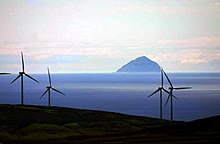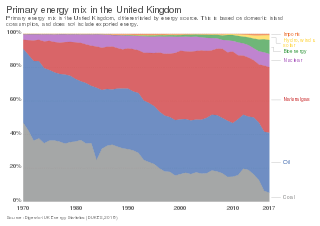Overview
| | This section is empty. You can help by adding to it. (November 2015) |
Energy policy in Scotland is a matter that has been specifically reserved to the UK parliament under the terms of the Scotland Act 1998 that created the devolved Scottish Parliament. [1] However, since planning is a matter that has been devolved, the Scottish government has the ability to shape the direction of energy generation in Scotland by approving or refusing new projects.
In 2004, the Enterprise Committee of the Scottish Parliament called for the development of a 'fully fledged' Scottish energy policy. [2]
The SNP Government that took power in May 2007 specifically included the word 'energy' in a portfolio title when the junior ministerial position of Minister for Enterprise, Energy and Tourism was created to replace the position of 'Minister for Enterprise and Lifelong Learning'.
| | This section is empty. You can help by adding to it. (November 2015) |
The closure of the Longannet power station in March 2016 ended coal-fired power production in Scotland. [3]

The production of renewable energy in Scotland is an issue that has come to the fore in technical, economic, and political terms during the opening years of the 21st century. [4] The natural resource base for renewable energy is extraordinary by European, and even global standards, with the most important potential sources being wind, wave, and tide.
At the end of 2011, there was 4,796 megawatts (MW) of installed renewables electricity capacity in Scotland, an increase of 9.5 per cent (416 MW) on the end of 2010. Renewable electricity generation in 2011 was a record high at 13,750 GWh - an increase of 44.5 per cent on 2010. Around 35 per cent of Scotland’s electricity came from renewables in 2011, exceeding the Scottish Government’s target of 31 per cent. Scotland contributed almost 40 per cent of the UK’s renewables output in 2011. [5]
Continuing improvements in engineering and economics are enabling more of the renewable resources to be utilised. Fears regarding "peak oil" and climate change have driven the subject high up the political agenda and are also encouraging the use of various biofuels. Although the finances of many projects remain either speculative or dependent on market incentives, it is probable that there has been a significant, and in all likelihood long-term change, in the underpinning economics. [6]
In addition to planned increases in both large-scale generating capacity and microsystems using renewable sources, various related schemes to reduce carbon emissions are being researched. [7] Although there is significant support from the public, private and community-led sectors, concerns about the effect of the technologies on the natural environment have been expressed. There is also an emerging political debate about the relationship between the siting, and the ownership and control of these widely distributed resources. [8]
A continuing political debate surrounds the uptake and the incentivisation schemes available for renewable technologies in Scotland. [9] There are tensions over the disparity in costs between renewable installations in Scotland compared to those in England with suggestion that this should be recognised by the UK government.[ citation needed ]
When the UK Government announced an energy review in early 2006, the Scottish National Party (SNP) and others made clear their view that Scotland did not need new nuclear power stations. [10] By January 2008, when the UK Government gave the go-ahead for a new generation of nuclear power stations to be built across the UK, the SNP formed the Scottish Government and First Minister Alex Salmond made clear there was "no chance" of more nuclear power stations being built in Scotland. [11] The Government's stance was backed by the Scottish Parliament which voted 63-58 to support the Scottish Government's policy of opposing new nuclear power stations. [12]
A proposed 400 kV upgrade to the existing 132 kV transmission network, [13] seen as key to future expansion [14] was held up in planning [15] for three years. There was vocal opposition from some sectors [16] and strong support from other sectors. [17] Objections were principally on the basis of the visual impact of the pylons running through the edge of the Cairngorms National Park. 53 km of the 132kV line inside the park was taken down and not replaced. [13] [18] The 220 km circuit will run from Beauly, west of Inverness to Denny, west of Falkirk near Edinburgh.
In 2008, the first major independent study associated with the Scottish Government’s renewable energy targets concluded that the upgrade of the Beauly-Denny power line will be a key to future development. [19]
In January 2010, the Scottish Government approved the upgrade to the Beauly to Denny transmission line, [20] which was energized by Christmas 2015. [21] [22]

Scottish Power is a vertically integrated energy company based in Glasgow, Scotland. It is a subsidiary of Spanish utility firm Iberdrola.
The Renewables Obligation (RO) is designed to encourage generation of electricity from eligible renewable sources in the United Kingdom. It was introduced in England and Wales and in a different form in Scotland in April 2002 and in Northern Ireland in April 2005, replacing the Non-Fossil Fuel Obligation which operated from 1990.

Longannet power station was a large coal-fired power station in Fife, and the last coal-fired power station in Scotland. It was capable of co-firing biomass, natural gas and sludge. The station stood on the north bank of the Firth of Forth, near Kincardine on Forth.
Nuclear power in the United Kingdom generated 16.1% of the country's electricity in 2020. As of August 2022, the UK has 9 operational nuclear reactors at five locations, producing 5.9 GWe. It also has nuclear reprocessing plants at Sellafield and the Tails Management Facility (TMF) operated by Urenco in Capenhurst.

Energy in the United Kingdom came mostly from fossil fuels in 2021. Total energy consumption in the United Kingdom was 142.0 million tonnes of oil equivalent in 2019. In 2014, the UK had an energy consumption per capita of 2.78 tonnes of oil equivalent compared to a world average of 1.92 tonnes of oil equivalent. Demand for electricity in 2014 was 34.42 GW on average coming from a total electricity generation of 335.0 TWh.

The energy policy of the United Kingdom refers to the United Kingdom's efforts towards reducing energy intensity, reducing energy poverty, and maintaining energy supply reliability. The United Kingdom has had success in this, though energy intensity remains high. There is an ambitious goal to reduce carbon dioxide emissions in future years, but it is unclear whether the programmes in place are sufficient to achieve this objective. Regarding energy self-sufficiency, UK policy does not address this issue, other than to concede historic energy security is currently ceasing to exist.

The United Kingdom is the best location for wind power in Europe and one of the best in the world. By 2023, the UK had over 11 thousand wind turbines with a total installed capacity of 28 gigawatts (GW): 14 GW onshore and 14 GW offshore, the sixth largest capacity of any country. Wind power generated about 25% of UK electricity, having surpassed coal in 2016 and nuclear in 2018. It is the largest source of renewable electricity in the UK.
E.ON UK is a British energy company and the largest supplier of energy and renewable electricity in the UK, following its acquisition of Npower. It is a subsidiary of E.ON of Germany and one of the Big Six energy suppliers. It was founded in 1989 as Powergen, and was listed on the London Stock Exchange and was once a constituent of the FTSE 100 Index. It has been a subsidiary of E.ON since 1 July 2002.
The Non-Fossil Fuel Obligation (NFFO) refers to a collection of orders requiring the electricity distribution network operators in England and Wales to purchase electricity from the nuclear power and renewable energy sectors. Similar mechanisms operate in Scotland and Northern Ireland.

SSE plc is a multinational energy company headquartered in Perth, Scotland. It is listed on the London Stock Exchange, and is a constituent of the FTSE 100 Index. SSE operates in the United Kingdom and Ireland.

The production of renewable energy in Scotland is a topic that came to the fore in technical, economic, and political terms during the opening years of the 21st century. The natural resource base for renewable energy is high by European, and even global standards, with the most important potential sources being wind, wave, and tide. Renewables generate almost all of Scotland's electricity, mostly from the country's wind power.

Wind power is the fastest-growing renewable energy technology in Scotland, with 9,347 megawatts (MW) of installed wind power capacity as of June 2020. This included 8,366 MW from onshore wind in Scotland and 981 MW of offshore wind generators.

Renewable energy in the United Kingdom contributes to production for electricity, heat, and transport.

The anti-nuclear movement in the United Kingdom consists of groups who oppose nuclear technologies such as nuclear power and nuclear weapons. Many different groups and individuals have been involved in anti-nuclear demonstrations and protests over the years.

Scotland has a long history of nuclear research and electricity generation. Nuclear energy consistently accounts for 20-80% of the electric supply in Scotland depending on weather conditions for wind power generation and electricity demand. As of 2022, there is only one remaining operating nuclear power station in Scotland (Torness).

Sustainable development in Scotland has a number of distinct strands. The idea of sustainable development was used by the Brundtland Commission which defined it as development that "meets the needs of the present without compromising the ability of future generations to meet their own needs." At the 2005 World Summit it was noted that this requires the reconciliation of environmental, social and economic demands - the "three pillars" of sustainability. These general aims are being addressed in a diversity of ways by the public, private, voluntary and community sectors in Scotland.
Aquamarine Power was a wave energy company, founded in 2005 to commercialise the Oyster wave energy converter, a device to capture energy from near-shore waves. The company's head offices were in Edinburgh, Scotland. The company ceased to trade on 20 November 2015.

The United Kingdom has a National Grid that covers most of mainland Great Britain and several of the surrounding islands, as well as some connectivity to other countries. The electrical sector supplies power at 50 Hz AC, and ~240 volts is supplied to consumers. In 2020 the electricity sector's grid supply came from 55% low-carbon power, 36.1% fossil fuelled power, and 8.4% imports. Renewable power is showing strong growth, while fossil fuel generator use in general and coal use in particular is shrinking, with historically dominant coal generators now mainly being run in winter due to pollution and costs, and contributed just 1.6% of the supply in 2020.

Douglas Chapman is a Scottish National Party (SNP) politician. He has been the Member of Parliament (MP) for Dunfermline and West Fife since the 2015 general election. He is the SNP's Small Business, Enterprise and Innovation spokesperson.